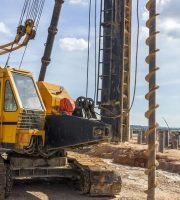In the field of construction engineering, we often hear the term “full scaffolding”. So, what does it actually mean? Today, we will provide a detailed explanation and extend the discussion to several daily issues related to it..
Scaffolding Ringlock System Ledger End
Full hall scaffolding, as the name suggests, refers to scaffolding erected at a certain distance and in accordance with regulatory requirements throughout the entire construction area. The characteristics of this type of scaffold are wide coverage area, stable structure, and the ability to withstand large loads. In construction projects, full scaffolding is commonly used to support formwork, construction platforms, or for high-altitude operations..
The full scaffold mainly consists of upright poles, horizontal bars, sweeping poles, scissor braces, etc. The upright pole is the vertical support of a scaffold, and the horizontal pole connects each upright pole to form a stable frame structure. The sweeping rod is located at the bottom of the scaffold to enhance overall stability. Scissor braces serve as diagonal supports, further enhancing the load-bearing capacity of the scaffold..
When setting up a full scaffolding, it is necessary to follow certain norms and requirements. Firstly, it is necessary to ensure that the foundation of the scaffold is solid, level, and able to withstand the weight and construction load of the scaffold. Secondly, the erection of scaffolding must comply with safety standards, such as strict control of the spacing between upright poles and the step spacing of horizontal bars. In addition, safety facilities such as wall connectors and scissor braces for scaffolding must also be in place..
Full hall scaffolding and fastener scaffolding differ in structure and usage scenarios. Coupler type scaffolding mainly consists of steel pipes and fasteners, which are connected together to form a stable support structure. This type of scaffolding is flexible to set up and suitable for various complex construction environments. Full hall scaffolding, on the other hand, places greater emphasis on integrity and stability, and is typically used in large-scale construction areas such as floor pouring and wall masonry..
Ensuring the safety of the full scaffolding requires multiple approaches. Firstly, the foundation of the scaffold should be treated before installation to ensure its solidity and flatness. Secondly, it is necessary to strictly follow the specifications and requirements for installation, and control key parameters such as the spacing between upright poles and the step distance of horizontal bars. In addition, it is necessary to regularly inspect and maintain scaffolding to promptly identify and address potential safety hazards. During use, safety operating procedures should be followed to avoid overloading and illegal operations..
When dismantling a full scaffold, the principle of “erecting before dismantling, and erecting before dismantling” should be followed. Specifically, it refers to the removal of components that were first erected, such as scissor braces, wall connectors, etc., and then the removal of components that were first erected, such as horizontal bars, upright bars, etc. During the dismantling process, the overall stability of the scaffolding should be maintained to avoid collapse accidents. Meanwhile, the dismantled components should be sorted and stacked neatly for future use or disposal..
Full hall scaffolding is one of the indispensable and important facilities in construction projects. Understanding its basic concepts, composition, and installation requirements is crucial for ensuring construction safety and smooth progress. I hope that the introduction and extended question answering in this article can help everyone better understand and apply the important tool of full scaffolding..
Thank you for reading! If you have any questions or suggestions about scaffolding or other construction related knowledge, please feel free to leave a message in the comments section to communicate with us. At the same time, you are also welcome to pay attention to our official account “Xiaoman Answers”, and we will regularly share more practical knowledge and experience of construction engineering! China Construction Fifth Engineering Bureau Attached Lifting Scaffold Training Handout 82 page PowerPoint file! case catalogue Plan! Content! What parts are included! Example! Downloaded website! Compile training materials for attached lifting scaffolding for China Construction Fifth Engineering Bureau, page 82 ppt.
Attachment type lifting scaffold (climbing frame) is a modern construction auxiliary equipment. It can climb or descend layer by layer with the engineering structure through its own lifting equipment and devices, and has safety devices to prevent overturning and falling. Compared to traditional climbing frames, the new type of climbing frame adopts universal porous frame technology, achieving bi-directional adjustment of horizontal and vertical bars, and improving the flexibility of layout. At the same time, the new climbing frame also has a front hanging non turnover lifting system, and the power equipment is embedded in the frame, reducing the risk of manual handling and equipment damage..
The design of the new climbing frame focuses on full steel sealing, improving the safety of the walkway board, flip board, and safety net. The intelligent overload and underload control system can automatically calculate the safety value of the load, achieve automatic alarm and shutdown for overload and underload, and ensure the safety and reliability of the lifting process. In addition, the new climbing frame also adopts fire and flame insulation technology, which improves the overall fire resistance performance..
Although the new climbing frame has improved in structural design and safety performance, there are also some drawbacks, such as poor ventilation which may lead to high temperatures inside the floor, heavy weight of the entire steel structure, long dismantling time, and long preparation time in the early stage..
The structure of the new climbing frame includes lower load-bearing beam, upper load-bearing beam, vertical keel, track, corner column, patterned plate keel plate, protective net, lifting bracket, rigid bracket, through wall screw, adjustable anti fall unloading support, sensor, electric hoist, mesh plate connection, wall support seat and guide rail, fully sealed inner springboard flipping plate, intelligent control accessories, and other components. The installation and use of these components must follow strict regulations and standards to ensure construction safety..
When installing the new climbing frame, specific steps and requirements need to be followed, including the positioning of the keel plate, the connection of the vertical keel, the connection between the guide rail and the keel plate, and the installation of the support buckle. During use, special attention should be paid to safety checks to ensure that the anti fall device is installed in place, the vertical cantilever height is appropriate, there are no obstacles inside the frame, the equipment is complete, the load-bearing rods are installed in place, and the building materials and garbage on the frame are cleaned up..
The implementation plan of the new climbing frame emphasizes the inspection requirements before and after installation and lifting, as well as during use, including confirmation of concrete structure strength, inspection and acceptance before installation and lifting, inspection and acceptance before lifting, and inspection and acceptance after lifting. These inspections are jointly carried out by the installation unit, general contracting unit, and supervision unit to ensure the safe use of the climbing frame# How to do # Plan # Special # Format # Standard # Direct Application # Earthwork Engineering # Compilation Basis # What are the Ten Points to Pay Attention to in Template Template Scaffolding Acceptance Scaffolding is an essential and important facility in construction, and is a work platform and passage built to ensure the safety and smooth progress of high-altitude operations. In recent years, scaffolding accidents have occurred frequently nationwide, and the main reasons are that the construction plan (operation manual) was not handled properly, construction personnel engaged in illegal construction, and inspection, acceptance, and tagging were not carried out properly. At present, scaffolding problems still exist everywhere in construction sites of various regions, and safety hazards are imminent. Management personnel must pay sufficient attention to the safety management of scaffolding, and strict acceptance inspection is particularly important..
2) After the completion of the first step of setting up the large crossbar for large and medium-sized scaffolding..
5) After reaching the design height (each layer of scaffolding for structural construction shall undergo one acceptance)..
6) After encountering winds of level 6 or above or heavy rain, the frozen area will thaw..



